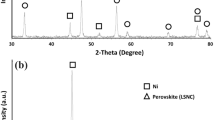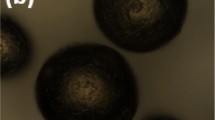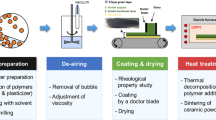Abstract
Ni sintering at high temperature (∼ 800 °C) operation drastically degrades the performance of Ni-yttria-stabilized zirconia (YSZ) anode in solid oxide fuel cell (SOFC). Mixed ionic and electronic conductive oxides such as CeO2 and Nb2O5 enhance the dispersion of Ni, CeO2 enhances the redox behavior and promotes charge transfer reactions, and Nb2O5 increases the triple phase boundary. In the present work, anode-supported SOFC is fabricated and tested in H2 fuel at 800 °C. YSZ and lanthanum strontium manganite (LSM)-YSZ are used as the electrolyte and composite cathode with NiO-YSZ, CeO2-NiO-YSZ, and Nb2O5-NiO-YSZ as an anode. The peak power density obtained for the cell with 10% CeO2–30% NiO-YSZ anode at the 5 and 25 h of operation is 330 and 290 mW cm−2 which is higher than that for 40% NiO-YSZ anode (275 mW cm−2 at 5 h). The peak power density obtained for the cell with 10% Nb2O5–30% NiO-YSZ anode at the 5 and 25 h of operation is 301 and 285 mW cm−2 which is higher than that for 40% NiO-YSZ anode (275 mW cm−2 at 5 h). Physical characterization has been carried to study morphology, elemental analysis, particle size, and phase formation of the fabricated anode before and after cell operation to correlate the cell performance.






Similar content being viewed by others
References
Minh NQ (1993) Ceramic fuel cells. J American Ceramic Soc 76:563–588
Klemenso T, Mogensen M (2007) Ni-YSZ solid oxide fuel cell anode behavior upon redox cycling based on electrical characterization. J American Ceramic Soc 90:3582–3588
Singh CA, Krishnan VV (2008) Anode characterization and SOFC performance using Ni-YSZ anodes formed by Ni impregnation methods. ECS Trans 6:25–32
Klemenso T, Thyden K, Chen M, Wang H-J (2010) Stability of Ni–Yttria stabilized zirconia anodes based on Ni-impregnation. J Power Sources 195:7295–7301
Singh CA, Bansal L, Tiwari P, Krishnan VV (2009) Strong metal support interaction (SMSI) of infiltrated Ni with TiO2 in a porous YSZ matrix—a possible method for Ni stabilization. ECS Tranactions 25(2):1897–1904
Tiwari P, Basu S (2013) Ni infiltrated YSZ anode stabilization by inducing strong metal support interaction between nickel and titania in solid oxide fuel cell under accelerated testing. Int J of Hydrogen Energ 38(22):9494–9499
Tiwari P, Basu S (2014) Performance studies of electrolyte supported solid oxide fuel cell with Ni-YSZ and Ni-TiO2-YSZ as anode. J Solid State Electr 18:805–812
Tiwari P, Basu S (2013) Comparison of performance of Ni-CeO2-YSZ and Ni-Nb2O5-YSZ anodes for solid oxide fuel cell. ECS Trans 57(1):1545–1552
Kanjanaboomalert T, Tzu TH, Sato K (2009) Electrocatalytic activity of an SOFC anode consisting of nickel, cerium oxide, and titanium oxide for the oxidation of methane. ECS Trans 16(24):23–29
Moon DJ, Park JM, Kang JS, Yoo KS, Hong SI (2006) Cogeneration of a synthesis gas and electricity through internal reforming of methane by carbon dioxide in a solid oxide fuel cell system. J Ind Engineering Chem 12(1):149–155
Patel S, Jawlik PF, Wang L, Jackson GS, Almansoor A (2012) Impact of cofiring ceria in Ni/YSZ SOFC anodes for operation with syngas and n-butane. J Fuel Cell Sci Tech 9:041002-1-7
Shishkin M, Ziegler T (2010) The electronic structure and chemical properties of a Ni/CeO2 anode in a solid oxide fuel cell: a DFT + U study. J Phys Chem C 114:21411–21416
Reich CM, Kaiser A, Irvine JTS (2001) Niobia based rutile materials as SOFC anodes. Fuel Cells 1(3–4):249–255
Choi S, Wang J, Cheng Z, Liu M (2008) Surface modification of Ni-YSZ using niobium oxide for sulfur-tolerant anodes in solid oxide fuel cells. J Electrochemical Soc 155(5):B449–B454
Author information
Authors and Affiliations
Corresponding author
Rights and permissions
About this article
Cite this article
Tiwari, P.K., Basu, S. CeO2 and Nb2O5 modified Ni-YSZ anode for solid oxide fuel cell. Ionics 23, 2571–2577 (2017). https://doi.org/10.1007/s11581-016-1945-1
Received:
Revised:
Accepted:
Published:
Issue Date:
DOI: https://doi.org/10.1007/s11581-016-1945-1




